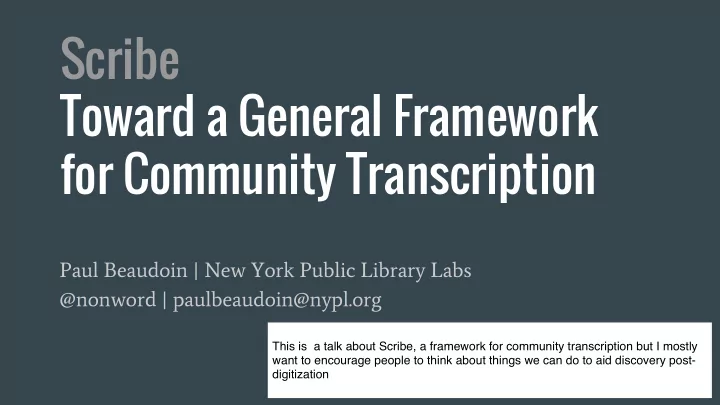

Scribe Toward a General Framework for Community Transcription Paul Beaudoin | New York Public Library Labs @nonword | paulbeaudoin@nypl.org This is a talk about Scribe, a framework for community transcription but I mostly want to encourage people to think about things we can do to aid discovery post- digitization
Cultural institutions of a certain age have this problem of having a lot of data that's stored away in forms that are difficult to analyze.
At its heart, there's a wealth of data here, but it's not expressed in discrete, human terms. Our minds are great at looking at this individual document and interpreting glyphs and phrases that represent discrete concepts and assertions. But this document as it stands doesn't lend itself to easy reading or comparison to other documents.
Digitization should include data extraction We should strive to extract semantic content from the array of pixels that digitization produces. Because frequently it's not about the image. Frequently there's a structure of data inside that document that is more useful for discovery, aggregate analysis. Maybe we can build a general tool for data extraction that uses humans.
NYPL and Zooniverse got together in late 2014 to collaborate on an NEH funded project to solve the problem of data extraction IN GENERAL
zooniverse.org The Zooniverse have been building crowd sourcing tools for a while to extract data from photos and video of the Serenghetti, 19th century ships logs, arctic penguins...
NYPL Labs has produced a number of projects around data extraction. Labs & Zooniverse came together to pool experience and resources to build a general purpose community data extraction tool.
Scribe: Configured around questions Questions about the document Questions about the locations of things Questions about those things Questions about the answers to those questions
The answers to these questions populate a tree that extends from the source documents out through a series of marks to a series of distinct transcriptions and potentially out to a series of votes that amplify or reduce the validity of competing answers.
Scribe: Emigrant City Running 4 months 5,000+ unique contributors 500,000+ classifications Emigrant City is a project around mortgage records from the Emigrant City Savings Bank in NYC late 19th, early 20th centuries.
Our core contributes between 10 and 99 classifications. Our all-star participant has contributed 32,621.
The Emigrant City flow works like this: 1. One day a user was presented with this and asked to mark the "Amount Loaned"
2. A different contributor, encountered that user’s mark and typed what they saw
Within 20 minutes, three distinct users encountered the same mark and transcribed the same text. This immediately verified the transcription as valid, promoting it to consensus data without the need for further verification.
Recent experimental work (at writing, not yet in master) adds to Scribe a facility for mapping the answers to these questions to a custom schema, with optional/mandatory, repeatable fields with specific types like date, int, dimensions, etc. We see that applied here to a not perfectly confident consensus transcription with two distinct transcriptions - probably disagreeing on the year, which is either 1870 or 1880. We’ve passed this free text transcription through some regex/ date parsing magic to derive a fully qualified DATE value.
This allows us to run smart queries against this field AS A DATE. Here I’m filtering on mortgage records between 1885 (jan 1) and March 15, 1890
Similarly, because we’re interpreting the free text transcription of the Amount Loaned field as “monetary”, making common substitutions and stripping non-numerics, we can run queries like this to inspect the highest payout mortgages.
Folks familiar with the big players in late 19th century Manhattan will recognize this name
For me, this comes full circle to a coloring contest I participated in when I was eight.
Turns out PT Barnum, of “P.T. Barnum's Greatest Show On Earth” took out a loan for 200,000 from the Emigrant Savings Bank on Dec 13 1880 (Also, incidentally, author of “The Art of Money Getting” in 1880, where he said “There is no greater mistake than when a young man believes he will succeed with borrowed money.”) He purchased JUMBO a little over a year later. Maybe using some borrowed funds.
/Scribe Toward a General Framework for Community Transcription scribeproject.github.io emigrantcity.nypl.org labs.nypl.org Paul Beaudoin | New York Public Library Labs @nonword | paulbeaudoin@nypl.org We encourage you to check out Scribe & Emigrant City as experiments in this greater effort to build generalized tools to extract data from our digitized assets.
Recommend
More recommend